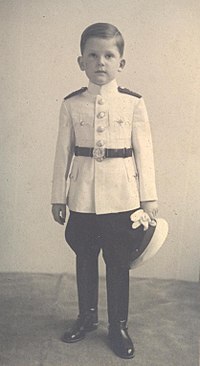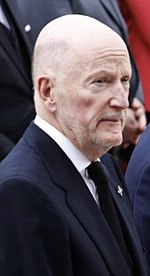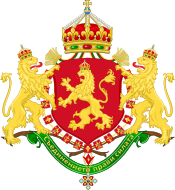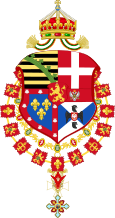
Quick Facts

Biography
Simeon II of Bulgaria (Bulgarian: Симеон Борисов Сакскобургготски, (transliteration: Simeon Borisov Sakskoburggotski) or Цар Симеон II (Tsar Simeon II); German: Simeon von Sachsen-Coburg und Gotha or Simeon von Wettin; Spanish: Simeón de Sajonia-Coburgo-Gotha; born 16 June 1937) is the last reigning Bulgarian monarch and later served as Prime Minister of Bulgaria from 2001 to 2005.
During his reign from 1943 to 1946 as Simeon II, Tsar of Bulgaria, he was a minor, with the royal authority being exercised over the kingdom on his behalf by a regency led by Simeon's uncle Prince Kiril, General Nikola Mihov and the prime minister, Bogdan Filov. In 1946 the monarchy was abolished as a consequence of a referendum, and Simeon was forced into exile in Spain. He returned to his home country in 1996 and formed the political party National Movement for Stability and Progress (NMSP) and became Prime Minister of the Republic of Bulgaria from July 2001 until August 2005. In the next elections he, as a leader of NMSP, took part in a coalition government with the ex-communist party BSP, and in 2009 after NMSP failed to win any seats in the Parliament, he left politics.
Simeon is one of the two last living heads of state from the time of World War II (the other is Tenzin Gyatso, 14th Dalai Lama of Tibet), the only living person who has borne the title "Tsar", and one of only two former monarchs in history to have become the head of government through democratic elections (the other is the now-deceased Norodom Sihanouk of Cambodia).
Royal history


Simeon was born to Boris III and Giovanna of Italy. Following his birth, Boris III sent an air force officer to the Jordan River to obtain water for Simeon's baptism in the Orthodox faith. He acceded to the throne on 28 August 1943 upon the death of his father, who had just returned to Bulgaria from a meeting with Adolf Hitler. Since Tsar Simeon was only six years old when he ascended the throne, his uncle Prince Kyril, Prime Minister Bogdan Filov, and Lt. General Nikola Mikhov of the Bulgarian Army were appointed regents.
Under his father, Bulgaria had reluctantly joined the Axis powers in World War II but had managed to preserve diplomatic relations with the Soviet Union. Still, on 5 September 1944 Stalin declared war on Bulgaria and three days later, the Red Army entered the country without encountering resistance. On the next day, 9 September 1944, Prince Kyril and the other regents were deposed by a Soviet-backed coup and arrested. The three regents, all members of the last three governments, Parliament deputies, heads of the army and eminent journalists were executed by the Communists in February 1945.
Towards exile
The royal family—Queen Giovanna, Simeon II, and his sister Maria-Louisa—remained at Vrana Palace near Sofia, while three new regents were appointed (Todor Pavlov, Venelin Ganev and Tsvetko Boboshevski). On 15 September 1946, a referendum was held in the presence of the Soviet army. It resulted in a 97% approval for republic and abolition of the monarchy, and the boy-king Simeon was deposed.
On 16 September 1946, the royal family was exiled from Bulgaria. Simeon II has never signed any abdication papers—neither at that moment when he was nine years old and his legal capacity to sign such an instrument would be questionable in any event, nor at any time later. The royal family first went to Alexandria, Egypt, where Queen Giovanna's father Vittorio Emanuele III, the former king of Italy, lived in exile. There, Simeon II finished Victoria College (along with Crown Prince Leka of Albania). In July 1951, General Franco's dictatorship in Spain granted asylum to the family.
Education and business career
In Madrid, Simeon studied at the Lycée Français, but did not graduate. On 16 June 1955, upon turning 18, in accordance with the Tarnovo Constitution Simeon II read his proclamation to the Bulgarian people as the Tsar of Bulgaria, confirming his will to be king of all Bulgarians and follow the principles of the Tarnovo Constitution and free Bulgaria. In 1958, he enrolled at Valley Forge Military Academy and College in the United States, where he was known as "Cadet Rylski No. 6883", and graduated as a second lieutenant. Once again in Spain (between 1959 and 1962), Simeon studied law and business administration.
He became a businessman. For thirteen years, he was chairman of the Spanish subsidiary of Thomson, a French defence and electronics group. He was also an adviser in the banking, hotel, electronics, and catering sectors.
Monarch in exile
Simeon issued several political declarations during his exile through his "chancellery" in Madrid directed at the Communist regime in Bulgaria and his exiled compatriots. His early attempts at forming an official government in exile did not come to fruition, however.
Marriage and issue
On 21 January 1962, Simeon married a Spanish aristocrat, Doña Margarita Gómez-Acebo y Cejuela. The couple have had five children – four sons (Kardam, Kiril, Kubrat and Konstantin) and a daughter, Kalina, all of whom subsequently married Spaniards. All of his sons received names of Bulgarian kings, his daughter has a Bulgarian name, although only three of his eleven grandchildren have Bulgarian names (Boris,Sofia and Simeon).
- Kardam (1962 – 7 April 2015) married Miriam de Ungría y López. They had two sons, Boris and Beltran.
- Kiril (born 1964) married María del Rosario Nadal y Fuster-Puigdórfila. They have two daughters, Mafalda and Olimpia, and one son, Tassilo.
- Kubrat (born 1965) married Carla María de la Soledad Royo-Villanova y Urrestarazu. They have three sons: Mirko, Lukás and Tirso.
- Konstantin-Assen (born 1967) married María García de la Rasilla y Gortázar. They have twins, Umberto and Sofia.
- Kalina (born 1972) married Antonio José "Kitín" Muñoz y Valcárcel. They have one son, Simeon Hassan Muñoz.
Political return
In 1990, just months after the fall of communism, Simeon was issued a new Bulgarian passport. In 1996, fifty years after the abolition of the monarchy, Simeon returned to Bulgaria and was met in many places by crowds cheering: "We want our King!" He did not, at that point, make any political announcements or moves. However, these monarchist sentiments gradually disappeared after his premiership and specifically during his coalition as a leader of NMSP with the ex-Communist Party, together with changing of generations; since by that time the majority of voters were born after the fall of the monarchy.
Various estates in Bulgaria that had been nationalised during the Communist era were returned to Simeon and his family. In 2001, Simeon, who had by this time taken the name Simeon Borisov Saxe-Coburg-Gotha, announced he would return to Bulgaria to form a new political party, the National Movement Simeon II (NMSII) (later renamed to NMSP), dedicated to "reforms and political integrity." Simeon promised that in 800 days the Bulgarian people would feel tangible positive effects of his government and would enjoy significantly higher standards of living.
Prime Minister
- For details on his cabinet, see: Sakskoburggotski Government
NMSP won a large victory in the parliamentary elections held on 17 June 2001, capturing 120 of the 240 seats in Parliament and defeating the two main pre-existing political parties. Simeon gave an oath as Prime Minister of Bulgaria on 24 July, forming a coalition with the ethnic Turkish party, Movement for Rights and Freedoms (MRF). He gave ministerial positions in his government mainly to technocrats and Western-educated economic specialists.
During his time in power, Bulgaria joined NATO. In 2002, he received the Path to Peace Award from the Path to Peace Foundation.
In the 2005 elections, Simeon's party ranked second and participated in the grand coalition government led by the Bulgarian Socialist Party and including the Movement for Rights and Freedoms. Simeon II was given the unofficial ceremonial post of Chairman of the Coalition Council.
The party got just 3.01% of votes and no seats at the parliamentary elections of 2009. Shortly after, on 6 July, Simeon also resigned as NMSP leader.
Views on restoration of the Bulgarian monarchy
Simeon II has never formally renounced his claim to the Bulgarian throne. He used the title "Tsar of the Bulgarians" in his political statements during his exile. Since his return to Bulgaria, however, Simeon has consistently declined to reveal his views on the restoration of the Bulgarian monarchy, notwithstanding the name of his party. His triumph in the 2001 elections raised the question of a possible restoration, especially with the economic crisis, poverty, and law and order issues the country faced after the fall of communism. Upon taking office as prime minister, he took an oath to protect the country's republican constitution.
Simeon II criticised the Bulgarian government in 2018 after he was told to return his palace taken in 1946. The decision came at a time with rising support of a restoration of the monarchy.
Autobiography
Simeon II wrote an autobiography in French under the title Simeon II de Bulgarie, un destin singulier that was released in Bulgaria on 28 October 2014. It was first presented at the headquarters of the UNESCO in Paris on 22 October 2014.
Heir to the House of Saxe-Coburg and Gotha-Koháry

After the death of his distant cousin Prince Johannes Heinrich of Saxe-Coburg and Gotha in April 2010 and due to the exclusion of the late prince's uncle Philipp and his descendants from his morganatic marriage with Sarah Aurelia Halasz, Simeon became the Head of the House of Saxe-Coburg and Gotha-Koháry, former magnates of Hungary and heir to the castles of Čabraď and Sv. Anton, both in modern-day Slovakia. In early 2012, he nominally ceded his rights (and those of his children) to the headship of the House and the title "Princess of Koháry" to his sister Marie Louise. In a statement published on its website on 1 May 2015, the Bulgarian Patriarchy announced that Simeon Saxe-Coburg-Gotha will be referred to as king of Bulgaria in all public and private services held in the dioceses of the Bulgarian Orthodox Church.
Longevity
Simeon turned 80 years old on 16 June 2017. If he lives to 31 December 2024, he will become the longest-lived head of state in Bulgarian history at 87 years, 198 days, surpassing Ferdinand I who holds the current record at 87 years, and 197 days when he died on 10 September 1948.
Titles, styles, honours and awards
Titles and styles
- 16 June 1937 – 28 August 1943: His Royal Highness The Prince of Tarnovo, Prince of Saxe-Coburg and Gotha, Duke of Saxony
- 28 August 1943 – 15 September 1946: His Majesty The Tsar of the Bulgarians
- 15 September 1946 – present: His Majesty The Tsar of the Bulgarians (used as a title of pretense and courtesy during his exile)
- 24 July 2001 – 17 August 2005: His Excellency Simeon Saxe-Coburg-Gotha (within Bulgaria as Prime Minister)
- 17 August 2005 – present: Mr Simeon Saxe-Coburg-Gotha (within Bulgaria as a civilian)
Dynastic honours
 House of Saxe-Coburg-Gotha-Koháry: Sovereign Knight Grand Cross with Chain of the Order of Saints Cyril and Methodius
House of Saxe-Coburg-Gotha-Koháry: Sovereign Knight Grand Cross with Chain of the Order of Saints Cyril and Methodius House of Saxe-Coburg-Gotha-Koháry: Sovereign Knight Grand Cross with Collar of the Royal Order of Saint Alexander
House of Saxe-Coburg-Gotha-Koháry: Sovereign Knight Grand Cross with Collar of the Royal Order of Saint Alexander House of Saxe-Coburg-Gotha-Koháry: Sovereign Knight Grand Cross with Chain of the Royal Order of Bravery
House of Saxe-Coburg-Gotha-Koháry: Sovereign Knight Grand Cross with Chain of the Royal Order of Bravery House of Saxe-Coburg-Gotha-Koháry: Sovereign Knight Grand Cross of the Royal Order of Civil Merit
House of Saxe-Coburg-Gotha-Koháry: Sovereign Knight Grand Cross of the Royal Order of Civil Merit House of Saxe-Coburg-Gotha-Koháry: Sovereign Knight Grand Cross of the Royal Order of Military Merit
House of Saxe-Coburg-Gotha-Koháry: Sovereign Knight Grand Cross of the Royal Order of Military Merit House of Saxe-Coburg-Gotha-Koháry: Sovereign Knight of the National Order of Labour
House of Saxe-Coburg-Gotha-Koháry: Sovereign Knight of the National Order of Labour House of Saxe-Coburg-Gotha-Koháry: Sovereign Knight of the Order of 9 September 1944
House of Saxe-Coburg-Gotha-Koháry: Sovereign Knight of the Order of 9 September 1944 House of Saxe-Coburg-Gotha-Koháry: Sovereign Knight of the Order of People's Freedom
House of Saxe-Coburg-Gotha-Koháry: Sovereign Knight of the Order of People's Freedom House of Saxe-Coburg-Gotha-Koháry: Sovereign recipient of the Coming of age Medal of King Simeon II
House of Saxe-Coburg-Gotha-Koháry: Sovereign recipient of the Coming of age Medal of King Simeon II
National state honours
 Bulgaria: Grand Cross of the Order of Stara Planina
Bulgaria: Grand Cross of the Order of Stara Planina Bulgarian Ministry of Defence: Collar of the Order of Justice
Bulgarian Ministry of Defence: Collar of the Order of Justice
Foreign state and dynastic honours
 Albanian Royal Family: Knight Grand Cross of the Order of Fidelity, Special Class
Albanian Royal Family: Knight Grand Cross of the Order of Fidelity, Special Class Belgium:
Belgium:- Knight Grand Cross of the Order of Leopold II
- Knight Grand Cross of the Order of the Crown
 France: Grand Officer of the Order of the Legion of Honour
France: Grand Officer of the Order of the Legion of Honour Orléans-French Royal Family: Knight Grand Cross with Collar of the Order of Saint Lazarus
Orléans-French Royal Family: Knight Grand Cross with Collar of the Order of Saint Lazarus
 Greek Royal Family: Knight Grand Cross of the Royal Order of the Redeemer
Greek Royal Family: Knight Grand Cross of the Royal Order of the Redeemer Italian Royal Family: Knight Grand Collar of the Supreme Order of the Most Holy Annunciation
Italian Royal Family: Knight Grand Collar of the Supreme Order of the Most Holy Annunciation Vatican: Knight Grand Cross of the Order of the Holy Sepulchre
Vatican: Knight Grand Cross of the Order of the Holy Sepulchre Sovereign Military Order of Malta: Bailiff Knight Grand Cross of Justice of the Sovereign Military Order of Malta, Special Class
Sovereign Military Order of Malta: Bailiff Knight Grand Cross of Justice of the Sovereign Military Order of Malta, Special Class Two Sicilian Royal Family:
Two Sicilian Royal Family:- Knight of the Royal Order of Saint Januarius
- Bailiff Knight Grand Cross of the Two Sicilian Royal Sacred Military Order of Saint George
 Jordan: Knight Grand Cordon of the Order of Independence
Jordan: Knight Grand Cordon of the Order of Independence Russian Imperial Family: Knight Grand Cordon with Collar of the Imperial Order of Saint Andrew
Russian Imperial Family: Knight Grand Cordon with Collar of the Imperial Order of Saint Andrew Spain:
Spain:- 1, 192nd Knight with Collar of the Order of the Golden Fleece
- Knight Grand Cross of the Order of Charles III
 Sweden: Recipient of the 70th Birthday Medal of King Carl XVI Gustaf
Sweden: Recipient of the 70th Birthday Medal of King Carl XVI Gustaf
National awards
 Bulgaria: Honorary degree of the National Guards Unit of Bulgaria
Bulgaria: Honorary degree of the National Guards Unit of Bulgaria Bulgaria: Jubilee badge of honour of the Bulgarian Chitalishte community
Bulgaria: Jubilee badge of honour of the Bulgarian Chitalishte community
Foreign awards
 European Union: Paneuropean Union integration award
European Union: Paneuropean Union integration award Romania: Honorary degree of the University of Bucharest
Romania: Honorary degree of the University of Bucharest
Arms
 |  |
Patronages
National patronages
 Bulgaria: Patron of the National day of Bulgaria
Bulgaria: Patron of the National day of Bulgaria
Foreign patronages
 Slovakia: Patron of restoration of the Statue of St. John of Nepomuk in Divina, realised out under auspices of the Embassy of the Federal Republic of Germany in Slovakia (2017).
Slovakia: Patron of restoration of the Statue of St. John of Nepomuk in Divina, realised out under auspices of the Embassy of the Federal Republic of Germany in Slovakia (2017).
 Gemini
Gemini